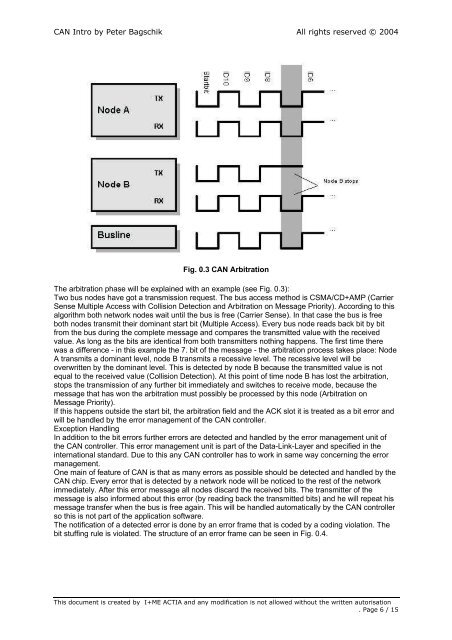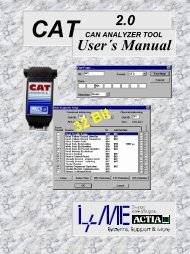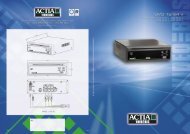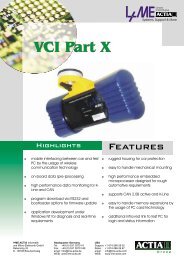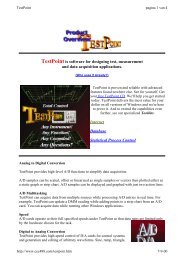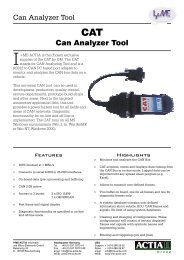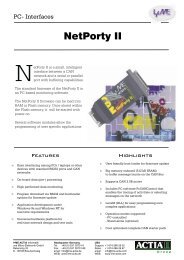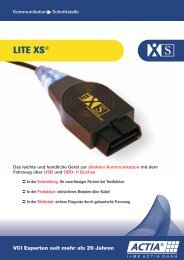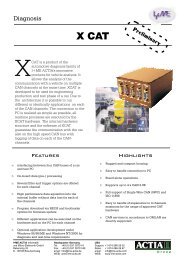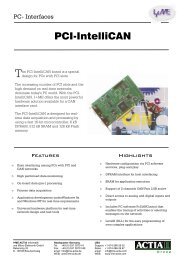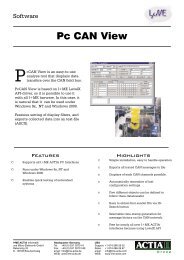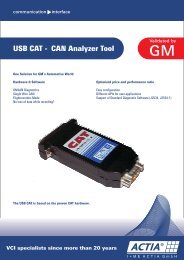An Introduction to CAN - I+ME ACTIA GmbH
An Introduction to CAN - I+ME ACTIA GmbH
An Introduction to CAN - I+ME ACTIA GmbH
You also want an ePaper? Increase the reach of your titles
YUMPU automatically turns print PDFs into web optimized ePapers that Google loves.
<strong>CAN</strong> Intro by Peter Bagschik All rights reserved © 2004<br />
Fig. 0.3 <strong>CAN</strong> Arbitration<br />
The arbitration phase will be explained with an example (see Fig. 0.3):<br />
Two bus nodes have got a transmission request. The bus access method is CSMA/CD+AMP (Carrier<br />
Sense Multiple Access with Collision Detection and Arbitration on Message Priority). According <strong>to</strong> this<br />
algorithm both network nodes wait until the bus is free (Carrier Sense). In that case the bus is free<br />
both nodes transmit their dominant start bit (Multiple Access). Every bus node reads back bit by bit<br />
from the bus during the complete message and compares the transmitted value with the received<br />
value. As long as the bits are identical from both transmitters nothing happens. The first time there<br />
was a difference - in this example the 7. bit of the message - the arbitration process takes place: Node<br />
A transmits a dominant level, node B transmits a recessive level. The recessive level will be<br />
overwritten by the dominant level. This is detected by node B because the transmitted value is not<br />
equal <strong>to</strong> the received value (Collision Detection). At this point of time node B has lost the arbitration,<br />
s<strong>to</strong>ps the transmission of any further bit immediately and switches <strong>to</strong> receive mode, because the<br />
message that has won the arbitration must possibly be processed by this node (Arbitration on<br />
Message Priority).<br />
If this happens outside the start bit, the arbitration field and the ACK slot it is treated as a bit error and<br />
will be handled by the error management of the <strong>CAN</strong> controller.<br />
Exception Handling<br />
In addition <strong>to</strong> the bit errors further errors are detected and handled by the error management unit of<br />
the <strong>CAN</strong> controller. This error management unit is part of the Data-Link-Layer and specified in the<br />
international standard. Due <strong>to</strong> this any <strong>CAN</strong> controller has <strong>to</strong> work in same way concerning the error<br />
management.<br />
One main of feature of <strong>CAN</strong> is that as many errors as possible should be detected and handled by the<br />
<strong>CAN</strong> chip. Every error that is detected by a network node will be noticed <strong>to</strong> the rest of the network<br />
immediately. After this error message all nodes discard the received bits. The transmitter of the<br />
message is also informed about this error (by reading back the transmitted bits) and he will repeat his<br />
message transfer when the bus is free again. This will be handled au<strong>to</strong>matically by the <strong>CAN</strong> controller<br />
so this is not part of the application software.<br />
The notification of a detected error is done by an error frame that is coded by a coding violation. The<br />
bit stuffing rule is violated. The structure of an error frame can be seen in Fig. 0.4.<br />
This document is created by <strong>I+ME</strong> <strong>ACTIA</strong> and any modification is not allowed without the written au<strong>to</strong>risation<br />
. Page 6 / 15


